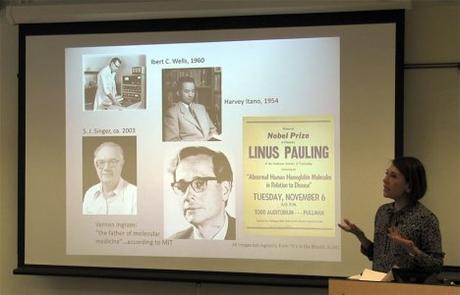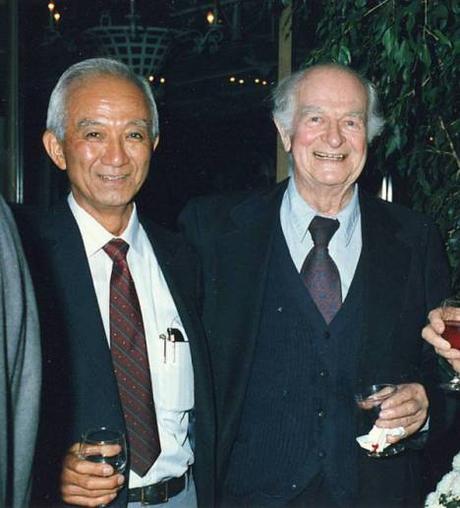
Dr. Edna Suárez-Díaz delivering her Resident Scholar lecture at the Valley Library, Oregon State University.
Dr. Edna Suárez-Díaz is the most recent individual to complete a term as resident scholar in the Oregon State University Libraries Special Collections and Archives Research Center. A professor in the Department of Evolutionary Biology at the Universidad Nacional Autónoma de México in Mexico City, Suárez-Díaz is an accomplished scholar of molecular evolution and molecular disease who serves on the editorial boards of Osiris and Perspectives on Science, among other publications.
Dr. Suárez-Díaz’ current research focus is the geopolitics of disease with a particular interest in approaches taken toward blood diseases in the twentieth century. This project brought her to Corvallis to study components of the Ava Helen and Linus Pauling Papers, focusing on Linus Pauling’s work on sickle cell anemia.
Pauling is, of course, well known for his discovery that sickle cell anemia traces its origin to the molecular level, a concept first published in 1949 with Harvey Itano, S. J. Singer and Ibert Wells. As Suárez-Díaz noted in her resident scholar lecture, the group’s finding that the basis of a complex physiological disease could emerge from a simple change in a single molecule made a profound impact on the history of biomedicine. Indeed, it is not an overstatement to suggest that the concept of a molecular disease led to massive shifts in post-war research and public policy.
Importantly, these shifts were accompanied by technological breakthroughs that enabled many other laboratories to explore new ideas related to molecular disease. In particular, the modernization of gel electrophoresis techniques served to democratize research in a way that had previously not been possible. When the Pauling group was conducting their initial experiments, electrophoresis was a tool that lay within the grasp of only a handful of well-funded laboratories. As the equipment and methodology required to do this work became less expensive, practitioners around the world began to enter the field and the impact was profound.
Suárez-Díaz is particularly interested in blood diseases and malaria in developing countries, noting that these afflictions were to the “Third World” what cancer was for industrialized societies and the middle classes. It is important to note as well that there exists a strong connection between blood diseases (like sickle cell anemia) and malaria, as the mutations that gave rise to blood diseases also provide a certain degree of immunity to malaria. As such, the geographic distribution of blood diseases correlates closely with malaria epidemiology, a phenomenon that has had consequences for public health campaigns over time, including decisions to use DDT on a massive scale in attempting to eradicate the mosquitoes that carry the disease.

Harvey Itano and Linus Pauling, ca. 1980s.
It is also interesting to chart Linus Pauling’s role – or lack thereof – in the further development of molecular disease as a field of study. Though he and three colleagues essentially created a new discipline with their 1949 paper, Pauling gradually became marginalized within the community, in part because he devoted so much of his time to political activism during the 1950s. His departure from Caltech in 1963 further distanced his scientific activities from what had, by then, become a truly international body of work.
As such, while undeniably important, Pauling’s contributions to the field might now be seen as one of many important nodes in a transnational network of scientists and practices. Moving forward, Suárez-Díaz’ work will continue to explore this transnational network, touching upon several other key issues including G6PD deficiency and the genetic consequences of atomic fallout.
Now in its eleventh year, the Resident Scholar Program at OSU Libraries has provided research support for more than two dozen visitors traveling from locations across the United States as well as international scholars from Germany, Brazil and, now, Mexico. New applications are generally accepted between January and April. To learn more, please see the Resident Scholar Program homepage.
Advertisements